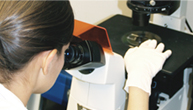
The major goal of our research program is to develop insight into lung physiology and pathology through understanding the mechanisms altering lung injury and repair and translating these findings into practical clinical solutions. Our research studies mainly focus on the role of matrix metalloproteinases (MMP) in normal physiology and in human disease including emphysema, atherosclerosis, cancer and vascular disease.
For a list of selected publications by Dr. D’Armiento, please visit our Publications page. For a complete list of publications by Dr. D’Armiento, please click here.
Lymphangioleiomyomatosis
The cystic lung disease seen in LAM is quite similar to the cysts seen in emphysema, and as such, I have a longstanding interest in this disease. Additionally, we have taken a lead role in investigating the possible role for HMGA2, an architectural transcription factor critical in the formation of mesenchymal tumors, in LAM pathogenesis. We were able to demonstrate the activation of the HMGA2 pathway in 100% of human and mouse tumor samples and revealed by genetic models an absolute requirement for HMGA2 activation in this disease. These studies have identified a novel molecular pathway that can generate therapeutic targets for use in treating LAM.
We are excited to announce that in September we will launch our first clinical trial with funding support from the Department of Defense. The trial will explore the use of a new drug for the treatment of LAM which has the potential to not only slow the progression of LAM but to also kill existing LAM cells.
Clinical Trial Announcement:
Columbia University in New York City and the Medical University of South Carolina in Charleston are beginning a phase 1 safety study called the “LAM Pilot Study of Imatinib mesylate” (LAMP-1). This study tests a drug called imatinib mesylate for LAM to determine safety and see if VEGF-D blood levels change. Potential participants can be on or off sirolimus, need to have a VEGF-D level > 200 pg/ml, and have an FEV1 <90% predicted. The two-month study of imatinib mesylate requires that the second month be off of sirolimus. Following the study, participants may resume any medication that is prescribed by their physician. Procedures performed during each visit include lung function tests, blood sampling, questionnaires, and a 6-minute walk test. This study requires 3 visits to Charleston or New York City for which travel reimbursement is $60 per visit. If you are interested in participating, more details are available by calling Caitlin Clancy in New York City at 212-305-3745 or emailing Laura Fonseca at lf2560@cumc.columbia.edu, or by calling Kim Brown in Charleston at 843-792-6474 or 800-785-3177 (toll free).
Smoke Induced Lung Injury
Our early work demonstrated that MMP-1 expression in the lung leads to tissue destruction. We have a large interest in redefining the mechanistic understanding of emphysema with the goal of providing the basis for novel therapeutic approaches. It has been hypothesized that the proteases leading to lung tissue destruction in emphysema come from the inflammatory cells infiltrating the tissue after smoke exposure. Our studies have identified the mechanisms by which cigarette smoke upregulates protease expression within airway epithelial cells, ultimately leading to tissue destruction. Our most recent MMP-1 related work has been in the identification of the toll-like receptor (TLR) 4 signaling cascade as an upstream regulator of MMP-1 expression. Blockade of this pathway inhibits cigarette smoke induction of MMP-1 in vitro.
In addition, our laboratory is now exploring pathways activated during epithelial injury in emphysema. We have established a role for the Wnt signaling pathway in emphysema and lung injurty. The Wnt inhibitor sFRP-1 is a regulator of lung progenitor cells and is critical in both normal lung development and lung injury. Extensive examination of this pathway in emphysema and lung injury in general determined that sFRP-1, an inhibitor of the WNT pathway, is critical for normal alveolar septation but during lung injury functions as a regulator of lung progenitor cells. These studies emphasize a novel role in tissue repair processes for molecules critical in lung development.
Cigarette Smoke Related Vascular Disease
Through the utilization of animal models of atherosclerosis, we have established a critical role for abnormal expression of MMPs, and their inhibitors, TIMPs, in disease pathogenesis. We have identified specific cigarette smoke components that cause MMP induction. Utilizing our smoke exposure models we have defined several important proteases involved in smoke induced injury in vascular disease and have recently identified a possible common pathway between atherosclerosis and emphysema.
Tissue Destruction in Alternative Lung Diseases
Over the last few years our laboratory has expanded studies examining the role of protease to other lung diseases including tuberculosis, acute lung injury, and lung metastasis. Our work in tuberculosis has demonstrated that MMP-1 is produced in the lungs of Tb infected individuals and Tb infection directly induces MMP-1. When MMP-1 expressing mice are infected with Tb these mice develop cysts and greater lung destruction. Other ongoing projects in the laboratory include an investigation of biomass exposure in two cohorts of women from India, as well as asthma related projects examining airway smooth muscle remodeling.

